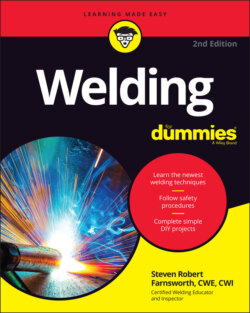Читать книгу Welding For Dummies - Steven Robert Farnsworth - Страница 16
Getting Familiar with Metals
ОглавлениеAny welding endeavor is much easier if you have a solid working knowledge of metals. The more you know about the metals you’re using and how they’re likely to respond to the intense heat involved in welding, the more likely you’ll be able to manipulate and join them in the way you have in mind for a specific project.
You probably remember from your high-school science class that, like other materials, metals expand when you heat them and contract as they cool off. If you heat them enough, they start to get soft, and eventually (with more heat), they melt. I know that sounds simple, but it’s awfully important for welding. Some metals melt at relatively low temperatures, and others have extremely high melting temperatures. A metal’s melting point is just one of several important properties for welding.
Here are just a few others to consider:
Ductility is a metal’s ability to change shape (bend, stretch, and so on) without breaking. Gold has a high level of ductility, whereas tungsten isn’t very ductile at all.
Electrical conductivity is a measure of how well a metal can conduct a current of electricity. Copper conducts electricity really well; by comparison, stainless steel isn’t a great conductor of electricity.
Strength is pretty self-explanatory: How much external force can a metal withstand without breaking? This one is very important for welding. Steel is a strong metal, but zinc isn’t.
You can read up on many more properties of metal, and the more you know, the more easily you can make smart decisions about how to weld those metals effectively.
Not all metals are widely used for welding, of course, and you probably won’t work with a huge range of metals in your welding shop until you’ve been welding for a while. That’s completely fine, however, because plenty of exciting welding projects — both fabricating and repairing — involve only a few select metals. (See “If You Can’t Beat ’Em, Join ’Em: Understanding Why Welding Matters” earlier in the chapter for more on those divisions.) For example, most of the welding practice exercises I walk you through in this book, as well as the welding projects I detail in Part 5, focus on three metals: steel, stainless steel, and aluminum. These three are the most commonly used metals for beginning welders, and you should take the time to get to know them. In the following sections, I give you a quick look at each one.
